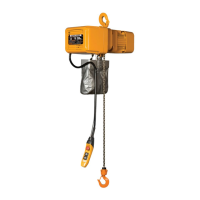32
How to use (continued)
■
Lifting/Lowering
• Do not lift more than the capacity. (Fig. E)
The capacity is indicated in the nameplate.
• Do not operate the electric chain hoist exceeding the lifting height.
• Do not dare to lift the structure or any other object supposed to be difficult
to lift.
• Do not lift a load at no-load side of the Load Chain.
• Do not stop the electric chain hoist with the limit switch (over winding prevention
device).
• Do not use the electric chain hoist when the Friction Clutch (overload
prevention device) is operated to stop winding.
• Do not lift or lower excessively.
• Do not remove the Chain Spring or the Cushion Rubber to operate the limit switch by
hitting the body size with the Bottom Hook. If such stop operation is repeated, it may
result in breaking of the Load Chain.
• Do not hit the body size with the End Stopper of the Load Chain to cause the operation
of the Friction Clutch. If such operation is repeated, it may result in breaking of the Load
Chain.
• Do not use the body size as a fulcrum. (Fig. F)
• Do not swing the lifted load.
• Do not wind the slack Load Chain with a load in one action to avoid
exposing the Load Chain to shock.
Stop lifting when the Load Chain is stretched tight. Then lift slowly.
• Do not carry out reverse operation while lifting/lowering a load.
When reversing the motion, stop the electric chain hoist and then reverse the motion.
• Do not carry out excessively frequent inching.
• Do not carry out plugging.
When reversing the motion, stop the electric chain hoist and then reverse the motion.
• When lifting off a load from a pallet, lift the load to avoid exposing to shock,
such as the load falling. (Fig. G)
• Do not cause the load to come into contact with the Load Chain.
• Do not rotate a lifted load. Use the device for rotation.
• Do not carry out the welding or cutting work on a lifted load.
• Do not repair or disassemble a lifted load.
When repairing or disassembling an electric chain hoist, ensure that the product is placed down
on the floor and that only maintenance engineers maintain the electric chain hoist.
• Do not enter beneath a lifted load.
• Do not hit the Chain Container with a load or slinging devices.
Otherwise the Load Chain in the Chain Container falls out of the bucket to cause injury.
Failure to comply with these instructions may result in death or serious injury.
Prohibited
• When the limit switch (over winding prevention device) is operated, stop the
lifting work immediately and lower the load.
• Move the electric chain hoist right above the load and then lift the load. (Do
not lift the load in an inclined direction.) (Fig. H)
• Do not leave from the operating position while a load is lifted. Watch the
lifted load.
Failure to comply with these instructions may result in death or serious injury.
Mandatory
over load
E
F
G
H
Chapter 1 Handling the Product
1
How to UseOperation
DANGER

